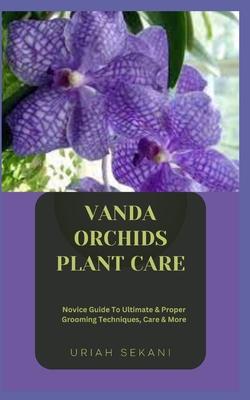
Book
Vanda Orchids Plant Care: Novice Guide To Ultimate & Proper Grooming Techniques, Care & More
by Uriah Sekani
(Write a Review)
Paperback
$8.99
The development pattern of Vanda orchids is one of their defining characteristics. Vanda orchids are epiphytic, meaning they grow naturally on other plants like trees, rather than being parasitic like many other types of orchids. Aerial roots, which tie the parasite to the host plant, draw nutrients and water from the air and rain.
The flowers of a vanda orchid are among the most spectacular in the world. The flowers range in size from a few millimeters to several inches in diameter, and their hues span the rainbow from deep violet to hot pink to pure white. The broadness and flatness of the petals give the flowers a confident and eye-catching appearance. The fragrant blossoms of some Vanda orchids are an added bonus to their visual appeal.
Because of their beautiful and long-lasting flowers, these orchids are highly sought after by collectors. Expert orchid gardeners and casual observers alike are captivated by the stunning show provided by some Vanda orchids, which can remain in bloom for weeks or even months.
Growing Vanda orchids is a complex and potentially lucrative hobby. They have very particular needs in terms of nourishment and atmosphere. Bright but indirect light, high humidity, and good air movement are all good for vanda orchids. To simulate their natural habitat, they are frequently cultivated in hanging baskets or placed on slabs of wood or tree fern. Overwatering can cause the roots to rot, so it's important to keep an eye on your plants and make sure they get enough water and fertilizer on a consistent basis.
Some Southeast Asian countries value vandas not just for their aesthetic value as ornamental plants, but also for the cultural significance they carry for local communities. They are commonly incorporated into religious rituals, floral arrangements, and offerings.
Vanda orchids, with their eye-catching design and enticing flowers, have gained popularity among amateur and professional gardeners alike. They are a rare gem among orchids because of their stunning appearance, unusual growth patterns, and wide range of colors.
The development pattern of Vanda orchids is one of their defining characteristics. Vanda orchids are epiphytic, meaning they grow naturally on other plants like trees, rather than being parasitic like many other types of orchids. Aerial roots, which tie the parasite to the host plant, draw nutrients and water from the air and rain.
The flowers of a vanda orchid are among the most spectacular in the world. The flowers range in size from a few millimeters to several inches in diameter, and their hues span the rainbow from deep violet to hot pink to pure white. The broadness and flatness of the petals give the flowers a confident and eye-catching appearance. The fragrant blossoms of some Vanda orchids are an added bonus to their visual appeal.
Because of their beautiful and long-lasting flowers, these orchids are highly sought after by collectors. Expert orchid gardeners and casual observers alike are captivated by the stunning show provided by some Vanda orchids, which can remain in bloom for weeks or even months.
Growing Vanda orchids is a complex and potentially lucrative hobby. They have very particular needs in terms of nourishment and atmosphere. Bright but indirect light, high humidity, and good air movement are all good for vanda orchids. To simulate their natural habitat, they are frequently cultivated in hanging baskets or placed on slabs of wood or tree fern. Overwatering can cause the roots to rot, so it's important to keep an eye on your plants and make sure they get enough water and fertilizer on a consistent basis.
Some Southeast Asian countries value vandas not just for their aesthetic value as ornamental plants, but also for the cultural significance they carry for local communities. They are commonly incorporated into religious rituals, floral arrangements, and offerings.
Vanda orchids, with their eye-catching design and enticing flowers, have gained popularity among amateur and professional gardeners alike. They are a rare gem among orchids because of their stunning appearance, unusual growth patterns, and wide range of colors.
Paperback
$8.99